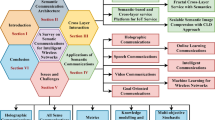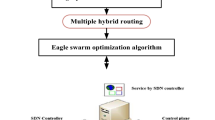Abstract
For massive data communication, the wireless network is often needed to support data transmission in complex environment. In this case, a portable, inexpensive and efficient wireless device is especially helpful. In order to realize this function, we propose a wireless self-organized connection strategy in this paper. We focus on a multihop wireless network with single relay at each hop. One of the challenges over this system is to set up the communication link optimally and automatically, which is also the main contribution of this paper. So we designed an On-Demand Cross-Layer Connection Strategy (ODCLCS) based on WLAN to achieve the data transmission between source and destination point. This strategy crosses application layer, transport layer, network layer and MAC layer. By using active scanning in MAC layer, proper nodes can be found and connected. The automatic routing method can get benefit from active scanning message, automatically allocate IP address for each node. At last, we develop a link maintenance function which works after the link is established. The link maintenance function using heartbeats communication mechanism to find link errors. Moreover, the link maintenance message is very short which can be neglected compared with the data stream. The ODCLCS is designed for Wireless Self-organized Link (WSOL) system. WSOL system aims to establish a stable and user-friendly communication link by using ODCLCS and other necessary programs. All programs are properly written and debugged repeatedly by us, which can work well on testbed devices. Performance evaluation using NS-3 simulator shows the characteristic of WSOL. The WSOL program for testbed is based on cfg80211 and mac80211 in Linux Kernel. And some API based on libnl library is invoked. The testing data provided verify the good performance of ODCLCS in reality.














Similar content being viewed by others
References
Carneiro G, Fortuna P, Ricardo M (2009) Flowmonitor: A network monitoring framework for the network simulator 3 (ns-3). In: Proceedings of the Fourth International ICST Conference on Performance Evaluation Methodologies and Tools, VALOOLS ’09, pp. 1:1–1:10. ICST (Institute for Computer Sciences, Social-Informatics and Telecommunications Engineering), ICST, Brussels, Belgium. https://doi.org/10.4108/ICST.VALUETOOLS2009.7493
Clausen T, Jacquet P (2003) Optimized link state routing protocol (olsr). Tech Rep
Demichelis C, Chimento P (2002) Rfc 3393: Ip packet delay variation metric for ip performance metrics (ippm). IETF November 2002
Fullmer C L, Garcia-Luna-Aceves J (1995) Floor acquisition multiple access (fama) for packet-radio networks. In: ACM SIGCOMM Computer communication review, vol 25. ACM, pp 262–273
Gast M (2005) 802.11 wireless networks: the definitive guide. O’Reilly Media Inc., Sebastopol
Gummalla A C V, Limb J O (2000) Wireless collision detect (wcd): Multiple access with receiver initiated feedback and carrier detect signal. In: 2000 IEEE International conference on communications. ICC 2000. Global convergence through communications. Conference record, vol 1. IEEE, pp 397–401
Guo Y, Li Z (2017) Wlan based wireless self-organization link: Research and realization. In: 2017 International conference on computer network, electronic and automation (ICCNEA). IEEE, pp 268–271
Haas Z J, Deng J (2002) Dual busy tone multiple access (dbtma)-a multiple access control scheme for ad hoc networks. IEEE Trans Commun 50(6):975–985
Hiertz G R, Denteneer D, Max S, Taori R, Cardona J, Berlemann L, Walke B (2010) Ieee 802.11 s: the wlan mesh standard. IEEE Wire Commun 17(1):104–111
Hu D, Wu J, Fan P (2016) Minimizing end-to-end delays in linear multihop networks. IEEE Trans Vehic Techno 65(8):6487–6496
Jawhar I, Mohamed N, Agrawal D P (2011) Linear wireless sensor networks: Classification and applications. J Netw Comp Appl 34(5):1671–1682
Johnson D B, Maltz D A, Broch J, et al. (2001) Dsr: the dynamic source routing protocol for multi-hop wireless ad hoc networks. Ad hoc networking 5:139–172
Karn P, et al. (1990) Maca-a new channel access method for packet radio. In: ARRL/CRRL Amateur radio 9th computer networking conference, vol 140. pp 134–140, London, Canada
Kleinrock L, Tobagi F (1975) Packet switching in radio channels: Part i - carrier sense multiple-access modes and their throughput-delay characteristics. IEEE Trans Commun 23(12):1400–1416. https://doi.org/10.1109/TCOM.1975.1092768
Lacage M, Henderson T R (2006) Yet another network simulator. In: Proceeding from the 2006 workshop on ns-2: the IP network simulator. ACM, p 12
Li L, Xiaoguang H, Ke C, Ketai H (2011) The applications of wifi-based wireless sensor network in internet of things and smart grid. In: 2011 6th IEEE conference on industrial electronics and applications, pp 789–793. https://doi.org/10.1109/ICIEA.2011.5975693
Ng P C, Liew S C (2007) Throughput analysis of ieee802. 11 multi-hop ad hoc networks. IEEE/ACM Trans Netw 15(2):309–322
Ogier R, Templin F, Lewis M (2004) Topology dissemination based on reverse-path forwarding (tbrpf). Tech Rep
Perkins C, Belding-Royer E, Das S. (2003) Ad hoc on-demand distance vector (aodv) routing. Tech Rep
Riley G F, Henderson T R (2010) The ns-3 network simulator. In: Modeling and tools for network simulation. Springer, pp 15–34
Shafiq M Z, Ji L, Liu A X, Pang J, Venkataraman S, Wang J (2013) A first look at cellular network performance during crowded events. In: ACM SIGMETRICS performance evaluation review, vol 41. ACM, pp 17–28
Stevens W R, Rudoff A M, Fenner B (2003) UNIX network programming Volume 1: the sockets networking API, vol 3. Addison-Wesley Professional, Reading
Wang X, Lim A O (2008) Ieee 802.11 s wireless mesh networks: framework and challenges. Ad Hoc Networks 6(6):970–984
Wu C S, Li V (1987) Receiver-initiated busy-tone multiple access in packet radio networks. In: ACM SIGCOMM Computer communication review, vol 17. ACM, pp 336–342
Acknowledgements
This work was supported by the Fundamental Research Funds for the Central Universities (CUC200D055), and the national sci-tech support plan, digital media technology development (2015BAK05B00, 2015BAK05B01).
Author information
Authors and Affiliations
Corresponding author
Additional information
Publisher’s note
Springer Nature remains neutral with regard to jurisdictional claims in published maps and institutional affiliations.
Rights and permissions
About this article
Cite this article
Guo, Y., Lv, R. & Li, Z. A realized on-demand cross-layer connection strategy for wireless self-organization link based on WLAN. Peer-to-Peer Netw. Appl. 13, 1442–1456 (2020). https://doi.org/10.1007/s12083-020-00896-4
Received:
Accepted:
Published:
Issue Date:
DOI: https://doi.org/10.1007/s12083-020-00896-4




